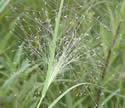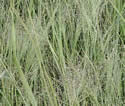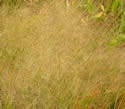Muhlenbergia asperifolia (Scratchgrass)
| Also known as: | Alkali Muhly |
|---|---|
| Genus: | Muhlenbergia |
| Family: | Poaceae (Grass) |
| Life cycle: | perennial |
| Origin: | native |
| Habitat: | part shade, sun; moist to wet sandy or gravelly soil; prairies, meadows, swales, seeps, wet ditches |
| Fruiting season: | August - September |
| Plant height: | 4 to 24 inches |
| Wetland Indicator Status: | GP: FACW MW: FACW NCNE: FACW |
| MN county distribution (click map to enlarge): |  |
| National distribution (click map to enlarge): |  |
Pick an image for a larger view. See the glossary for icon descriptions.
Detailed Information
Flower: 

![[photo of panicle]](/udata/r9ndp23q/pd3/muhlenbergia-asperifolia-108232015-t.jpg) Open, wispy, branching cluster at the top of the stem, 2½ to 6 inches long and about as wide. Branches are very slender and wiry, widely spreading with the lowest branches initially erect and partially tucked inside the uppermost sheath, later extending out and becoming spreading. Spikelets (flower clusters) are single at the tips of wiry branchlets, each spikelet 1.5 to 2 mm long usually with a single floret, occasionally 2 or 3 florets.
Open, wispy, branching cluster at the top of the stem, 2½ to 6 inches long and about as wide. Branches are very slender and wiry, widely spreading with the lowest branches initially erect and partially tucked inside the uppermost sheath, later extending out and becoming spreading. Spikelets (flower clusters) are single at the tips of wiry branchlets, each spikelet 1.5 to 2 mm long usually with a single floret, occasionally 2 or 3 florets.
![[close-up of branches]](/udata/r9ndp23q/pd3/muhlenbergia-asperifolia-14-4-t.jpg) At the base of a spikelet is a pair of bracts (glumes), both thin, translucent whitish to purplish, hairless, 1-veined, blunt to pointed at the tip, the lower glume 1 to 1.5 mm (to 1/16 inch) long, the upper glume slightly longer. Florets are surrounded by a pair of bracts (lemma and palea), both similar, longer and thicker than the glumes, 1.2 to 2.1 mm long, hairless, often turning dark grayish or purplish, the lemma weakly 3-veined and awnless, sometimes with an abrupt point at the tip, the palea 2-veined and pointed at the tip.
At the base of a spikelet is a pair of bracts (glumes), both thin, translucent whitish to purplish, hairless, 1-veined, blunt to pointed at the tip, the lower glume 1 to 1.5 mm (to 1/16 inch) long, the upper glume slightly longer. Florets are surrounded by a pair of bracts (lemma and palea), both similar, longer and thicker than the glumes, 1.2 to 2.1 mm long, hairless, often turning dark grayish or purplish, the lemma weakly 3-veined and awnless, sometimes with an abrupt point at the tip, the palea 2-veined and pointed at the tip.
Leaves and stems: 

![[photo of leaves]](/udata/r9ndp23q/pd3/muhlenbergia-asperifolia-115-1-t.jpg) Leaves are alternate, 1 to 3 inches long, 1 to 3 mm (to 1/8 inch) wide, rough-textured, mostly flat or sometimes folded, and may be crowded with overlapping sheaths.
Leaves are alternate, 1 to 3 inches long, 1 to 3 mm (to 1/8 inch) wide, rough-textured, mostly flat or sometimes folded, and may be crowded with overlapping sheaths.
![[photo of sheath, ligule and node]](/udata/r9ndp23q/pd3/muhlenbergia-asperifolia-14-5-t.jpg) Sheaths are smooth to slightly rough-textured and more or less keeled on the back. The ligule (membrane where the leaf joins the sheath) is up to 1 mm long, straight across to jagged along the tip edge with a sparse fringe of hairs. Nodes are smooth and mostly hidden in the sheaths. Stems are hairless, unbranched, ascending or spreading from the base and rising near the tip (decumbent), single or a few from the base, and form colonies from scaly rhizomes.
Sheaths are smooth to slightly rough-textured and more or less keeled on the back. The ligule (membrane where the leaf joins the sheath) is up to 1 mm long, straight across to jagged along the tip edge with a sparse fringe of hairs. Nodes are smooth and mostly hidden in the sheaths. Stems are hairless, unbranched, ascending or spreading from the base and rising near the tip (decumbent), single or a few from the base, and form colonies from scaly rhizomes.
Fruit: 
![[close-up of immature spikelets]](/udata/r9ndp23q/pd3/muhlenbergia-asperifolia-15-13-t.jpg) The florets drop off individually when mature leaving the glumes behind on the stalk. Grains (seeds) are brown and up to 1 mm long.
The florets drop off individually when mature leaving the glumes behind on the stalk. Grains (seeds) are brown and up to 1 mm long.
Notes:
Muhlenbergia is a rather variable genus: clusters spike-like or an open panicle; glumes or lemmas awned, or neither; the callus (base of the floret) covered in long hairs or not; some with hairy stems or sheaths, others hairless; some branched, some not; clump forming or not; annual or perennial. What they have in common are spikelets usually single-flowered (occasionally with 2 or 3 florets), membranous ligules (occasionally also fringed with hairs), narrow leaves, glumes usually 1-veined, lemmas usually 3-veined, paleas 2-veined, and mature florets usually dropping off above the glumes (occasionally at the spikelet branch). There are about 70 species native to North America and more than 150 species worldwide.
Scratchgrass is found in our western counties, where it reaches the eastern edge of its natural range, in moist, often saline soils. Farther east it is considered an introduction, commonly a weed of salted roadsides. Of the 10 Muhlenbergia species known to be in Minnesota, it is one of two with hairless leaves, stems and sheaths, an open panicle, spikelets up to about 2 mm long and single at branchlet tips, glumes shorter than the lemmas, neither glumes nor lemmas awned, and the callus lacking long hairs. Scratchgrass also has a panicle about as long as wide, a fine fringe of hair on the ligule, relatively short leaves with overlapping sheaths, the nodes mostly hidden.
The most similar species is Bog Muhly (Muhlengergia uniflora), which has a narrower panicle, distinctly longer than wide, none of the branches enclosed in the sheath, and is only known from the arrowhead region, typically found in sandy, gravelly or peaty soils on shores, banks and wetlands, often in thin soils over bedrock. The panicle of Scratchgrass bears a resemblance to both Fall Witch Grass (Digitaria congnata) and Purple Lovegrass (Eragrostis spectabilis), both of which have at least some hairs on the sheaths, and the entire panicle breaks off at maturity, blowing away tumbleweed-style. Scratchgrass and Purple Lovegrass share another trait: late in the season, a colony can form a cloud or mist-like patch that may be seen from some distance, Purple Lovegrass a purple mist and Scratchgrass a pale straw-colored cloud.
Native Plant Nurseries, Restoration and Landscaping Services ↓
More photos
Photos by K. Chayka taken in North Dakota. Photos by Peter M. Dziuk taken in Clay County and in North Dakota.
Comments
Have you seen this plant in Minnesota, or have any other comments about it?







 Scratchgrass plant
Scratchgrass plant Scratchgrass plants
Scratchgrass plants a cloud of Scratchgrass
a cloud of Scratchgrass Scratchgrass in a wet ditch
Scratchgrass in a wet ditch